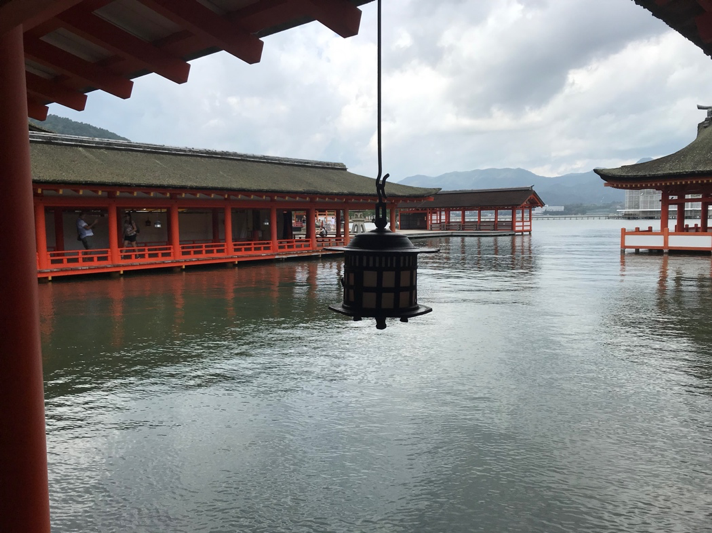Oct 31, 2019
Miyajima: The Shrine Island of Hiroshima
The tradition of Miyajima centers on the belief it is the place where the Gods dwell and by virtue is a sanctified place. The Great Torii gate, which according to the Shinto faith is a boundary between the spirit and human worlds, boldly marks the landing entrance to the island. The gate itself is a designated National Important Cultural Property and seemly floats approx. 200 meters offshore from the splendid Itsukushima Shrine. The first gate was erected in 1168 and the current one has stood since 1875.
**Please note that the gate is currently undergoing refurbishment and shrouded in hoardings thereby will not be properly visible until August 20120.
The shrine complex consists of a number of National Treasures and Important Cultural Properties and dates back to the 6th century though was later modified to its present structure in the 12th century by order of the famed feudal warlord Taira Kiyomori – in fact this plays into the rise of the samurai class to take control of the nation. His family was in a power struggle with another important family for control, and the story goes that a Shinto priest came to Kiyomori in a dream ordering him to redevelop the shrine so he took it upon himself that if he did so he would surely be rewarded with the top job (Shogun – the outcome of this struggle, by the way, was the inception of the feudal military dictatorships that ruled the archipelago for the next 600 odd years).
You might ask yourself why the gate and shrine structure are off-shore. Shinto essentially is all about the reverence for nature. In accordance with that belief, the spirit gods dwell in the sky, the rock, the sun, trees all things ad infinitum. Thus, it was perceived that the natural spiritual beauty of the island would be desecrated by man-made structures so the shrine and gate were built offshore. The brilliant vermillion lacquered structure of the shrine buildings appears to float above the rising and receding tide of the blue inland sea and sharply contrasted by the green virgin forest in background – of course, once the shrine was expanded by the Taira warlord the shrine became an important pilgrimage destination and a such the regulation of no structures onshore had to be relaxed. Weekends, it is not uncommon to see a wedding ritual at the main altar in the complex.
On purchasing entry to Itsukushima Shrine, I do recommend paying the extra 100-yen to include entry to the Treasure Hall, right opposite the exit from the shrine. This quaint yet somewhat opulently decorated museum displays a small scale but beautiful selection of feudal garments, ceramic ware and paneled art, armor, weaponry, and other artifacts.
Another site I recommend is Daishoin temple located behind the sprawling township at the foothills of Mt Misen. It is nestled among statue dotted gardens and is a lovely stroll. Be sure to go into the grotto up the back of the temple precinct to view the 44 statues of Buddhist saints and stunning overheard lamp display. And the starkly empty and austere ancient beauty of Senjokaku, located next to the towering Five-Story Pagoda certainly deserves a look.
Miyajima also, is, without doubt, a gastronomic experience. Famous for its oysters, unique Hiroshima style okonomiyaki anago meshi (grilled sea eel on rice), or a repast at one of the plenty of eateries offering customary Japanese fare. If you fancy after lunch coffee, head to Miyajima Coffee on the Omotesando shopping street for real barista-made coffee – in my humble opinion, one of the best coffee shops in Western Japan. Or perhaps a craft beer at the Miyajima Brewery just a bit further along the road.
Afterward, you might like to walk this off with a peaceful wander through around the quiet solemnity of the many shrines and temples, or through Momijigadani Park where you may encounter, though hopefully ignored by wandering deer that also populate the island. From the park, you can access the ropeway aerial gondola ride to the top of Mt Misen, or for the more energetic take the hike up, quite literally topping off the experience with its absolutely spectacular view of the surrounding Seto Inland Sea environs. Otherwise, you might be happy enough to wander around curiosities shops in Omote Sando shopping street or the back streets.
There are such a lot of wonderful experiences to be shared on the island and I recommend making a full day of it.
Access to Miyajimaguchi:
– Hiroden tram #1 from anywhere downtown straight to Miyajimaguchi Port. ¥380
– JR Sanyo Line from platform #1 at Hiroshima Station ¥410
From Miyajimaguchi take the 15-minute ride across the channel on either of the two ferry services operating. ¥180 each way.
Alternatively, you can take a 40-minute ride on the fast boat from the Peace Memorial Park bridge that tours you down the river before whisking you across the Inland Sea straight to the island. ¥1500 one way.
More Articles about Miyajima (there are a lot!)
Photo By Author Hugh Cann


About the author